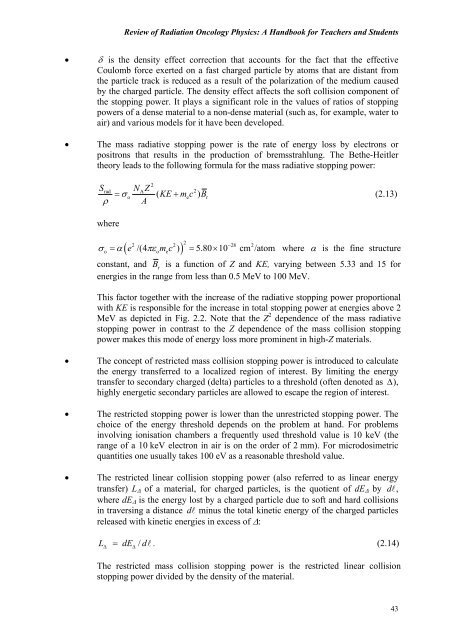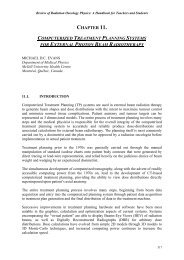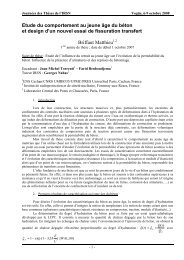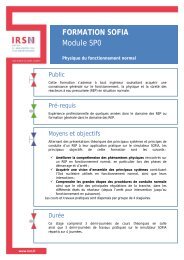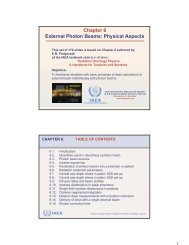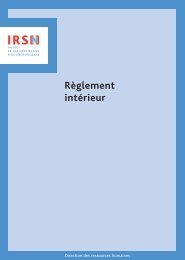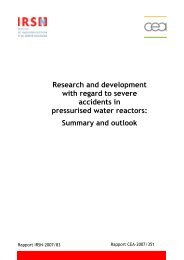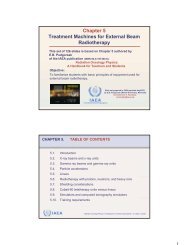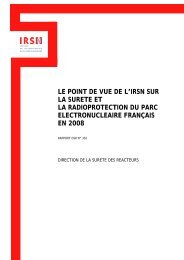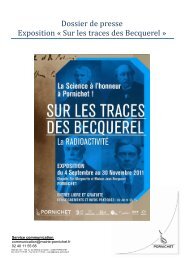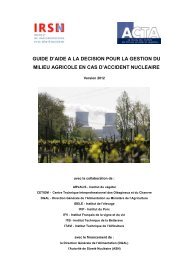chapter 2. dosimetric principles, quantities and units - IRSN
chapter 2. dosimetric principles, quantities and units - IRSN
chapter 2. dosimetric principles, quantities and units - IRSN
You also want an ePaper? Increase the reach of your titles
YUMPU automatically turns print PDFs into web optimized ePapers that Google loves.
Review of Radiation Oncology Physics: A H<strong>and</strong>book for Teachers <strong>and</strong> Students• δ is the density effect correction that accounts for the fact that the effectiveCoulomb force exerted on a fast charged particle by atoms that are distant fromthe particle track is reduced as a result of the polarization of the medium causedby the charged particle. The density effect affects the soft collision component ofthe stopping power. It plays a significant role in the values of ratios of stoppingpowers of a dense material to a non-dense material (such as, for example, water toair) <strong>and</strong> various models for it have been developed.• The mass radiative stopping power is the rate of energy loss by electrons orpositrons that results in the production of bremsstrahlung. The Bethe-Heitlertheory leads to the following formula for the mass radiative stopping power:SN Z2radA2σo( KE mec ) Bρ = A+ r(<strong>2.</strong>13)where( ) 22 2 −28 2σ = α e /(4 πε m c ) = 5.80× 10 cm /atom where α is the fine structureo o econstant, <strong>and</strong> B ris a function of Z <strong>and</strong> KE, varying between 5.33 <strong>and</strong> 15 forenergies in the range from less than 0.5 MeV to 100 MeV.This factor together with the increase of the radiative stopping power proportionalwith KE is responsible for the increase in total stopping power at energies above 2MeV as depicted in Fig. <strong>2.</strong><strong>2.</strong> Note that the Z 2 dependence of the mass radiativestopping power in contrast to the Z dependence of the mass collision stoppingpower makes this mode of energy loss more prominent in high-Z materials.• The concept of restricted mass collision stopping power is introduced to calculatethe energy transferred to a localized region of interest. By limiting the energytransfer to secondary charged (delta) particles to a threshold (often denoted as ∆),highly energetic secondary particles are allowed to escape the region of interest.• The restricted stopping power is lower than the unrestricted stopping power. Thechoice of the energy threshold depends on the problem at h<strong>and</strong>. For problemsinvolving ionisation chambers a frequently used threshold value is 10 keV (therange of a 10 keV electron in air is on the order of 2 mm). For micro<strong>dosimetric</strong><strong>quantities</strong> one usually takes 100 eV as a reasonable threshold value.• The restricted linear collision stopping power (also referred to as linear energytransfer) L ∆ of a material, for charged particles, is the quotient of dE ∆ by dl,where dE∆ is the energy lost by a charged particle due to soft <strong>and</strong> hard collisionsin traversing a distance dl minus the total kinetic energy of the charged particlesreleased with kinetic energies in excess of ∆:L = dE / dl. (<strong>2.</strong>14)∆∆The restricted mass collision stopping power is the restricted linear collisionstopping power divided by the density of the material.43


